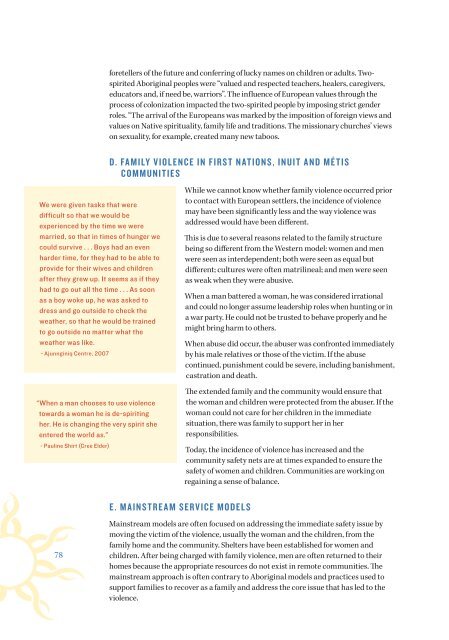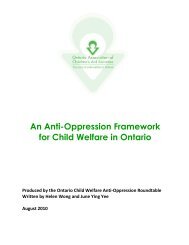English - Ontario Association of Children's Aid Societies
English - Ontario Association of Children's Aid Societies
English - Ontario Association of Children's Aid Societies
Create successful ePaper yourself
Turn your PDF publications into a flip-book with our unique Google optimized e-Paper software.
foretellers <strong>of</strong> the future and conferring <strong>of</strong> lucky names on children or adults. Twospirited<br />
Aboriginal peoples were “valued and respected teachers, healers, caregivers,<br />
educators and, if need be, warriors”. The influence <strong>of</strong> European values through the<br />
process <strong>of</strong> colonization impacted the two-spirited people by imposing strict gender<br />
roles. “The arrival <strong>of</strong> the Europeans was marked by the imposition <strong>of</strong> foreign views and<br />
values on Native spirituality, family life and traditions. The missionary churches’ views<br />
on sexuality, for example, created many new taboos.<br />
We were given tasks that were<br />
difficult so that we would be<br />
experienced by the time we were<br />
married, so that in times <strong>of</strong> hunger we<br />
could survive . . . Boys had an even<br />
harder time, for they had to be able to<br />
provide for their wives and children<br />
after they grew up. It seems as if they<br />
had to go out all the time . . . As soon<br />
as a boy woke up, he was asked to<br />
dress and go outside to check the<br />
weather, so that he would be trained<br />
to go outside no matter what the<br />
weather was like.<br />
- Ajunnginiq Centre, 2007<br />
“When a man chooses to use violence<br />
towards a woman he is de-spiriting<br />
her. He is changing the very spirit she<br />
entered the world as.”<br />
- Pauline Shirt (Cree Elder)<br />
D. FAMILY VIOLENCE IN FIRST NATIONS, INUIT AND MÉTIS<br />
COMMUNITIES<br />
While we cannot know whether family violence occurred prior<br />
to contact with European settlers, the incidence <strong>of</strong> violence<br />
may have been significantly less and the way violence was<br />
addressed would have been different.<br />
This is due to several reasons related to the family structure<br />
being so different from the Western model: women and men<br />
were seen as interdependent; both were seen as equal but<br />
different; cultures were <strong>of</strong>ten matrilineal; and men were seen<br />
as weak when they were abusive.<br />
When a man battered a woman, he was considered irrational<br />
and could no longer assume leadership roles when hunting or in<br />
a war party. He could not be trusted to behave properly and he<br />
might bring harm to others.<br />
When abuse did occur, the abuser was confronted immediately<br />
by his male relatives or those <strong>of</strong> the victim. If the abuse<br />
continued, punishment could be severe, including banishment,<br />
castration and death.<br />
The extended family and the community would ensure that<br />
the woman and children were protected from the abuser. If the<br />
woman could not care for her children in the immediate<br />
situation, there was family to support her in her<br />
responsibilities.<br />
Today, the incidence <strong>of</strong> violence has increased and the<br />
community safety nets are at times expanded to ensure the<br />
safety <strong>of</strong> women and children. Communities are working on<br />
regaining a sense <strong>of</strong> balance.<br />
78<br />
E. MAINSTREAM SERVICE MODELS<br />
Mainstream models are <strong>of</strong>ten focused on addressing the immediate safety issue by<br />
moving the victim <strong>of</strong> the violence, usually the woman and the children, from the<br />
family home and the community. Shelters have been established for women and<br />
children. After being charged with family violence, men are <strong>of</strong>ten returned to their<br />
homes because the appropriate resources do not exist in remote communities. The<br />
mainstream approach is <strong>of</strong>ten contrary to Aboriginal models and practices used to<br />
support families to recover as a family and address the core issue that has led to the<br />
violence.

















